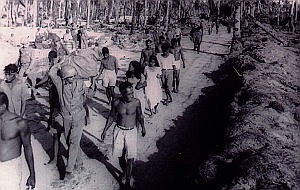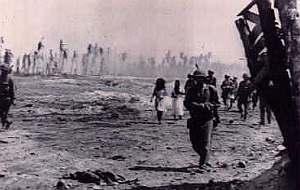 |
KWAJALEIN ATOLL REPUBLIC OF THE MARSHALL ISLANDS |
 |
| HOME | LIVING | AVIATION | MARINE | PET INFO | * HISTORY * | ISLANDS | LINKS | MEDIA | PHOTOS | SERVICES | SITE MAP | ABOUT |
 |
KWAJALEIN ATOLL REPUBLIC OF THE MARSHALL ISLANDS |
 |
| HOME | LIVING | AVIATION | MARINE | PET INFO | * HISTORY * | ISLANDS | LINKS | MEDIA | PHOTOS | SERVICES | SITE MAP | ABOUT |
| H I S T O R Y | |||||||||
| BEFORE WWII |
DURING WWII |
1944 BILL ILES |
1944 CURTIS PARTCH |
1947 ED SPILMAN |
1950 - 1951 GENE WOOLIEVER |
1951 - 1969 |
1970 - 1989 |
1990 - 1994 |
HISTORY COMES ALIVE |
 |
World War II Part 2 |
D-Day on Kwajalein
Feb. 1, 1944
After a near perfect amphibious assault this morning on beaches at the west end of Kwajalein Island, troops of the 32nd and 184th Regimental Combat Teams and the 767th Tank Battalion have advanced approximately one third the length of the island against stiffening Japanese resistance. The most devastation naval, artillery, and air bombardment yet seen in the Pacific began at dawn and continued until H-Hour. At one time, two shells per second were hitting specific targets and areas ahead of the assault troops.
Altogether, nearly 7,000 14-inch, 8-inch, and 5-inch shells hit Kwajalein today from supporting naval vessels alone. Most of them landed on the main beaches before the assault. Field artillery on Enubuj (Carlson) expended 29,000 round of 105mm and 155mm ammunition. Heavy bombers flew from Tarawa to drop 15 1,000- and 2,000-pound bombs on the landing area. Carriers-based dive and torpedo bombers and fighters flew a total of 96 supporting sorties.
As the landing craft started for shore, Navy aircraft made a last strafing run. Artillery shells from Enubuj were still hitting the beach when the LVTs were within 35 yards. The first wave of troops landed exactly on schedule at 0930 at Red Beach 1 (in the vicinity of the invasion beach marker). One minute later, troops went shore at Read beach 2 (near USAKA Photo Lab). Within 12 minutes, 1,200 men and their equipment had landed without a single casualty, and amphibious tanks had advanced 100 yards to support the troops as they organized.
So effective was the pre-landing bombardment that Japanese resistance was at first largely confined to sporadic small arms fire as the 32nd RCT advanced along the ocean side, and the 184th RCT moved forward on the lagoon side. By 1130, determined Japanese resistance had developed, but U.S. troops continued their advancement. By about 1800, they had driven approximately 1,600 yards along the length of the island from the landing beaches.
The 184th has established defensive positions for the night on a line inland of the lagoon (just west of Bldg. 1010), with the 32nd dug in on a line inland from the ocean (in the area of the weather station). American casualties at the end of the first day of the Battle of Kwajalein Island are 17 dead and 46 wounded. Japanese casualties are estimated at 500 killed, 11 captured.
Second Day
Feb. 2, 1944
At the end of the second day's fighting on Kwajalein Island, hopes are high for a speedy victory tomorrow. But U.S. troops are wary and watchful tonight for "Banzai"- suicide counterattacks- by the 200 to 300 Japanese believed to be the only enemy survivors. Reports from prisoners indicate that 1,000 to 1,200 Japanese were killed in the assault today, and that remaining defense positions are in ruins, with all communications broken. Orders have come from the headquarters of Maj. Gen. C.H. Corlett, Commander of the 7th Infantry Division, to be alert, as "the Japanese soldier makes his suicide counterattack at dawn on the day after his cause becomes hopeless."
Today's action began at 0715, when men of the 32nd and 184th Regimental Combat Teams and 767th Tank Battalion moved forward after 15 minutes of preparatory fire from artillery on Enubuj (Carlson) Island. Advancing along the ocean side, the 32nd, with support tanks, reduced two Japanese strong points "Cat" (in the vicinity of the Country Club and golf course) and "Corn" (at the east end of the runway). Corn was protected by an elaborate tank trap that extended nearly halfway across the island. These troops are dug in for the night in the abandoned trenches and shell craters around the tank trap.
The 184th, in its push up the lagoon side, met considerable resistance in the area now covered by fresh water tanks. There, the rubble of a large number of buildings offered enough cover for Japanese snipers and machine gun crews. Because tanks assigned to the 184th had been loaned to the 32nd for assault on "Corn" strong point, the infantry advance has been temporarily stalled. The 184th has taken positions for the night on al line slightly westward of that of the 32nd.
U.S. casualties for the day total 11 killed in action and 241 wounded. In 70 sorties today, carrier-based planes dropped 40 tons of bombs and expended 20,800 round of .50 caliber ammunition. No Japanese aircraft has been seen operation in the entire Marshall Islands area.
Naval units of the Kwajalein Island Defense Group and transports carrying reserve forces arrived in the lagoon today. The hospital ship Relief also arrived today.
 |
 |
Day Three
Feb. 3, 1944
U.S. infantrymen pushed forward today against a fanatically determined and heavily defended enemy to gain another thousand yards in the Battle of Kwajalein. It was the costliest day yet for American troops on the island, with 54 killed in action and 255 wounded. Last night's estimates by prisoners of 200 to 300 Japanese survivors proved to be way off the mark. The 184th regimental Combat Team reports 800 to 1,000 Japanese killed in their area. In one huge block house alone, 200 dead were found, most of them apparent suicides. The 32nd reports and additional 300 enemy dead in the advance along the ocean side.
U.S. troops had expected to make a rapid advance to the north end of Kwajalein today, but the 184th ran into serious trouble shortly after it moved out at 0715. As infantrymen approached the Admiralty area (around what is now the intersection of 9th St. and Lagoon Rd.), they came without warning upon the most heavily fortified area of the island. Facing them on the rear edge of this area stood a great blockhouse of reinforced concrete. Fifty yards beyond, nearly undamaged by bombardment, were two huge shelters of thick, reinforced concrete, steel plate, and logs under a mound of sand several feet thick. Other underground shelters and concrete blockhouses, intact and active, were scattered through dense ruins, rubble, and trees.
One observer described it as "trying to fight one's way across the landscape of a nightmare. "Small, often isolated, groups of infantry with rifles and whatever demolition charges they could carry or drag, blasted out one nest of Japanese after another. Smoke and flying debris were so thick that units operations 10 yards apart were unaware of each other's presence.
One building was found to be empty. To prevent its possible reentry by enemy troops, it was demolished and set afire. Later it was discovered that the building had contained all the beer, sake, and candy the Japanese had on Kwajalein. Only a few bottles of beer were saved.
The 32nd RCT had an easier time of it. From their jump-off point to about the location of the Terminal Building, there was little resistance. Then a pillbox off to the left (about where the projection booth of Richardson Theater is situated) caused a temporary halt. Demolition charges and 75mm shells from medium tanks drove the enemy out one by one. With resistance continuing light, the 32nd has advanced to the area of the Adult Pool.
As night falls, the threat of Japanese counterattack increases. Some incidents have occurred as far as 1,000 yards behind the 32nd's advance positions. Just after sunset, bugle was heard among the Japanese at the foot of the pier at 6th St., followed by a headlong attack by screaming Japanese. They were cut down to the last man.
Illuminating shells and naval searchlights, together with sporadic artillery and naval fire, are being employed to lessen the chance of night attack. But the American troops on Kwajalein are tensely awaiting the expected dawn charge.
Ebeye
Another phase of the Battle of Southern Kwajalein Atoll began this morning when the 17th Regimental Combat Team made an amphibious assault on Ebeye (Burton), chief Japanese seaplanes base in the Marshalls. Among Japanese facilities there are more than 120 machine shops, warehouses, and other buildings.
A 100-yard-wide concrete ramp for seaplanes extends about 300 yards along the northern lagoon shore, with large hangars and repair shops nearby. A 160-yard concrete pier extends into the lagoon about midway along the coast.
This morning's preliminary naval and air bombardment was so effective that on the landing beach (lagoon side, south end of Ebeye) and for 200 yards inland, no live Japanese were encountered. The advance proceeded steadily northward, slowed somewhat by enemy pillboxes and large number of individual rifle pits in which Japanese soldiers lie concealed, waiting for a chance to fire on U.S. troops. Through resistance is determined, it seems to consist mainly of individual and small group action without apparent direction. Some Japanese were discovered fighting with spears made of bayonets attached to poles.
The 17th RCT has taken defensive positions for the night on a line about 50 yards south of the pier. Big and Little Buster, between Kwajalein and Ebeye, were also taken under fire today, and occupation was completed by 1630.
 |
 |
The battle of Kwajalein is over.
Feb. 4, 1944
At dusk today, men of the 32nd Regimental Combat Team surged across the last 150 yards of the island, over-running the one remaining bunker and gun emplacement (now known as Bunker Hill, near Qtrs 223).
Across the lagoon, two and a half miles to the north, U.S. troops can see where another American victory was won today. Ebeye was declared fully secured at 1537, after the 17th RCT made a fast, almost unopposed, advance from the pier to the north shore.
The final action on Kwajalein began at sunrise, shortly after 0700, when the 32nd pushed off from last night's bivouac (near the Adult Pool) for an advantage along the ocean to 6th St., where the team was to fan out for a sweep over the entire island to the north end. Almost immediately, there was heavy fire from Japanese who had been bypassed yesterday (near the Pacific Bachelor Quarters). The advance was stalled for nearly three hours, as units turned aside to clean out positions firing on them. At the same time, the 184th RCT was encountering pockets of determined resistance in the area between the Admiralty and the lagoon (around 9th St. and Lagoon Rd.).
Today, for the first time since the landings, the enemy has surrendered in considerable numbers. Many have been isolated, without water, for the past two days. Thirty-one Koreans and a Japanese scurried out of one building after the 184th brought up a loud speaker and Nisei interpreters, who broadcast promises of food, water, and immunity from harm. More than 90 prisoners were taken by the 184th during the morning. In another area, men of the 32nd covered five Korean prisoners with BARs and moved them from shelter to shelter while the prisoners persuaded others to surrender. In less than an hour, 33 prisoners were taken.
By 1300, the 184th had reached its objective at the foot of the pier. After cutting off enemy withdrawal across 5th St., the 184th turned its attention to a thorough mop-up of areas to the rear. By 1430, all enemy action had been overcome on the lagoon side from landing beaches to the pier. The 2nd Battalion, 32nd RCT, was in position north of 6th St. at 1345 to begin its final assault (through what is now the trailer and old housing area).
The ground was tangle of debris interlaced with trenches, many of which contained long-dead bodies. The stench of decay and the acrid odor of burned palm wood filled the air. With satchel charges, grenades, and ultimately flame throwers, the 32nd cleared dugouts and still-active pillboxes and blockhouses. When the weary victors reached the northern tip of the island at 1920, organized resistance had ceased.
 |
 |
Operation of the southern atoll complete.
Feb. 5, 1944
The Southern Invasion Force today completed occupation of Southern Kwajalein Atoll from Ennugeliggelap in the west to Gellinam in the east. American losses were: 142 dead, 2 missing in action, 845 wounded. The best estimate of enemy losses in Southern Kwajalein Atoll is 4,938 dead and 206 prisoners, including 127 Koreans.
Feb. 6, 1944
After a day spent burying enemy dead, the men of the 32nd and 184th RCTs turned Kwajalein Island over to garrison and defense forces.
![]()
Bucholz Army Air Field
Named for Pfc. Fred H. Bucholz, a member of Co. F, 3rd Platoon, who was killed in the last three hours of the Battle of Kwajalein, fighting near what is now quarters 222 and 224. He and his Sergeant were attempting to clear out Japanese soldiers who were holed up in shelters. Both men had thrown captured explosives into one of the shelters. Thinking that the explosion had killed the holdouts, they stood to survey the damage. From another shelter, a Japanese rifleman fired out a roof opening, striking Bucholz in the back and killing him instantly. Only about an hour before, Bucholz had rescued his wounded Lieutenant.
Richardson Theater
Named for the U.S. Army's Commanding General of the Central Pacific Area in 1944. Gen. Robert Richardson was responsible for training and logistical supply for the invasion of the Southern Kwajalein Atoll. Built in 1944, the Rich was one of seven theaters on island, and is the only one remaining. In the early years, Quonset huts by the Rich were home to the chapel, Special Services, radio station WXLG, the library, and the Hourglass.
Tinker's Grave
Tinker, the Japanese dog that survived the fighting on Kwajalein, was buried in 1962 near the turtle pond. Tinker had been taken in by the folks on Kwaj and lived out his days here.
Dyess Field
On the last day of the invasion, Feb. 2, 1944, Lt. Col. Aquilla J. Dyess was leading a group of men on a charge against a Japanese position, when machine gun fire took his life only hours before the invasion was complete. He was highest-ranking officer to have been killed in the battles for Kwajalein, Roi, and Namur. After the battle on Roi, some of the men had hung a sign unofficially naming the airport Dyess Field. It wasn't until 1967 that the field was officially named. For his actions on Roi, Lt. Col. Dyess was awarded the Medal of Honor.
Corlett Recreation Center
Maj. Gen. Charles H. Corlett, 7th Infantry Division, commanded invasion forces at the Southern end of Kwajalein Atoll. The building named for him was built in 1985. It houses a gym where basketball, volleyball, and youth soccer are played, as well as classrooms that host various community functions like church groups and community education.
| H I S T O R Y | |||||||||
| BEFORE WWII |
DURING WWII |
1944 BILL ILES |
1944 CURTIS PARTCH |
1947 ED SPILMAN |
1950 - 1951 GENE WOOLIEVER |
1951 - 1969 |
1970 - 1989 |
1990 - 1994 |
HISTORY COMES ALIVE |